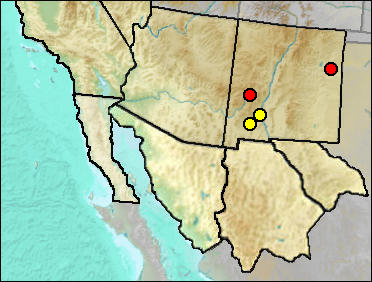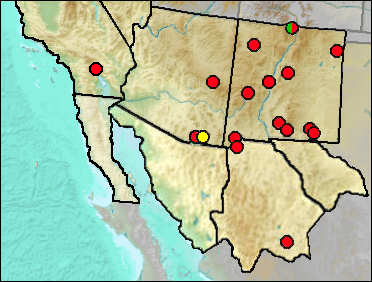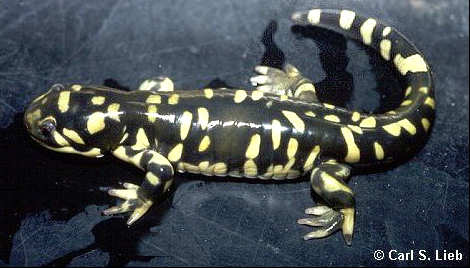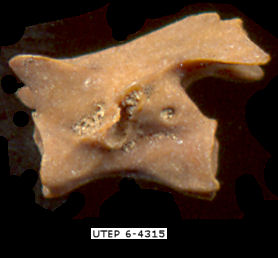Class Amphibia
Order Caudata
Family Ambystomatidae

McMullen and Zakrzewski (1972) listed this salamander from the possibly Illinoian Casados local fauna. In view of the uncertainty of age, assignment is to the Rancholabrean.
Sites.
Late Blancan: Caballo (Morgan et al. 2011); Kelly Canyon (Morgan et al. 2011).
Latest Blancan: La Union (Morgan and Harris 2015)
Rancholabrean: Casados Ranch (Morgan and Lucas 2005).
Late Wisconsin: VLA (Morgan et al. 2009).
Literature Cited. McMullen and Zakrzewski 1972; Morgan et al. 2009; Morgan et al. 2011.
Ambystoma mavortium Baird 1850—Barred Tiger Salamander
Synonyms. Ambystoma tigrinum.
Southwestern tiger salamanders have generally been recognized as A. tigrinum. Shaffer and McKnight (1996), however, published evidence that the subspecies A. tigrinum tigrinum is a species distinct from other subspecies of tiger salamanders. Thus the more western populations, as a different species from A. tigrinum, received the next available name, A. mavortium. Most authorities have accepted this changed taxonomy. Published records of fossils from our region have been under the name A. tigrinum.
In the Southwest, most assignments to species of ambystomatid salamanders likely are on the basis of geography rather than morphology since there is only one lowland salamander in the region today (other regional salamanders are small, montane forms). The result is the tendency to assign any moderate-size salamander to this species, and late Wisconsin occurrences are listed here as that species.
Most moderate to large faunas include at least a few specimens. Although often taken to imply wet conditions, individuals often occur in arid situations well away from standing water, taking refuge in crevices and rodent burrows; pools of water are necessary for breeding, however.


Fig. 1 (left). Barred Tiger Salamander (Ambystoma mavortium). Photograph by Carl S. Lieb. Fig. 2 (right). Fossil Ambystoma mavortium vertebra from Harris' Pocket, Dry Cave.
Sites.
Late Blancan: California Wash (Morgan and White 2005); Curtis Ranch (Brattstrom 1955).
Medial Irvingtonian: SAM Cave (Rogers et al. 2000).
Rancholabrean: Papago Springs Cave (Czaplewski and Mead et al. 1999: cf.); Pit Stop Quarry (Mead 2005; Murray et al. 2005); Tramperos Creek (White and Morgan 2011).
Wisconsin: White Lake (UTEP).
Mid Wisconsin: Papago Springs Cave (Czaplewski and Mead et al. 1999: cf.); Pendejo Cave (Harris 2003); U-Bar Cave (Harris 1987).
Mid/Late Wisconsin/Holocene: Jimenez Cave (Messing 1986); Sierra Diablo Cave (UTEP).
Late Wisconsin: Animal Fair 18-20 ka (Harris 1993c); Arroyo de las Tinajas 7A (UTEP); Balcony Room (UTEP); Bison Chamber (Holman 1970); Charlies Parlor (Harris 1993c); Dark Canyon Cave (UTEP); Estancia Valley (Bachhuber 1990); Harris' Pocket (Holman 1970); Lake Otero (UTEP); Pendejo Cave (Harris 2003); Stalag 17 (Harris 1993c); TT II (Harris 1993c); U-Bar Cave 14-15 ka; U-Bar Cave 15-18 ka; U-Bar Cave 18-22 ka (UTEP).
Late Wisconsin/Holocene: Bat Cave (Scarbrough 1986); Conkling Cavern (UTEP); Howell's Ridge Cave (Van Devender and Worthington 1977);Mountain View Country Club (Jefferson 2014); Pendejo Cave (Harris 2003); SAM Cave (Rogers et al. 2000); Sheep Camp Shelter (Harris 1993c).
Literature Cited. Bachhuber 1989; Brattstrom 1955; Czaplewski and Mead et al. 1999; Harris 1993c, 2003; Holman 1970; Jefferson 2014; Mead 2005; Messing 1986; Morgan and White 2005; Murray et al. 2005; Rogers et al. 2000; Scarbrough 1986; Shaffer and McKnight 1996; Van Devender and Worthington 1977; White and Morgan 2011.
Last Update: 10 May 2015